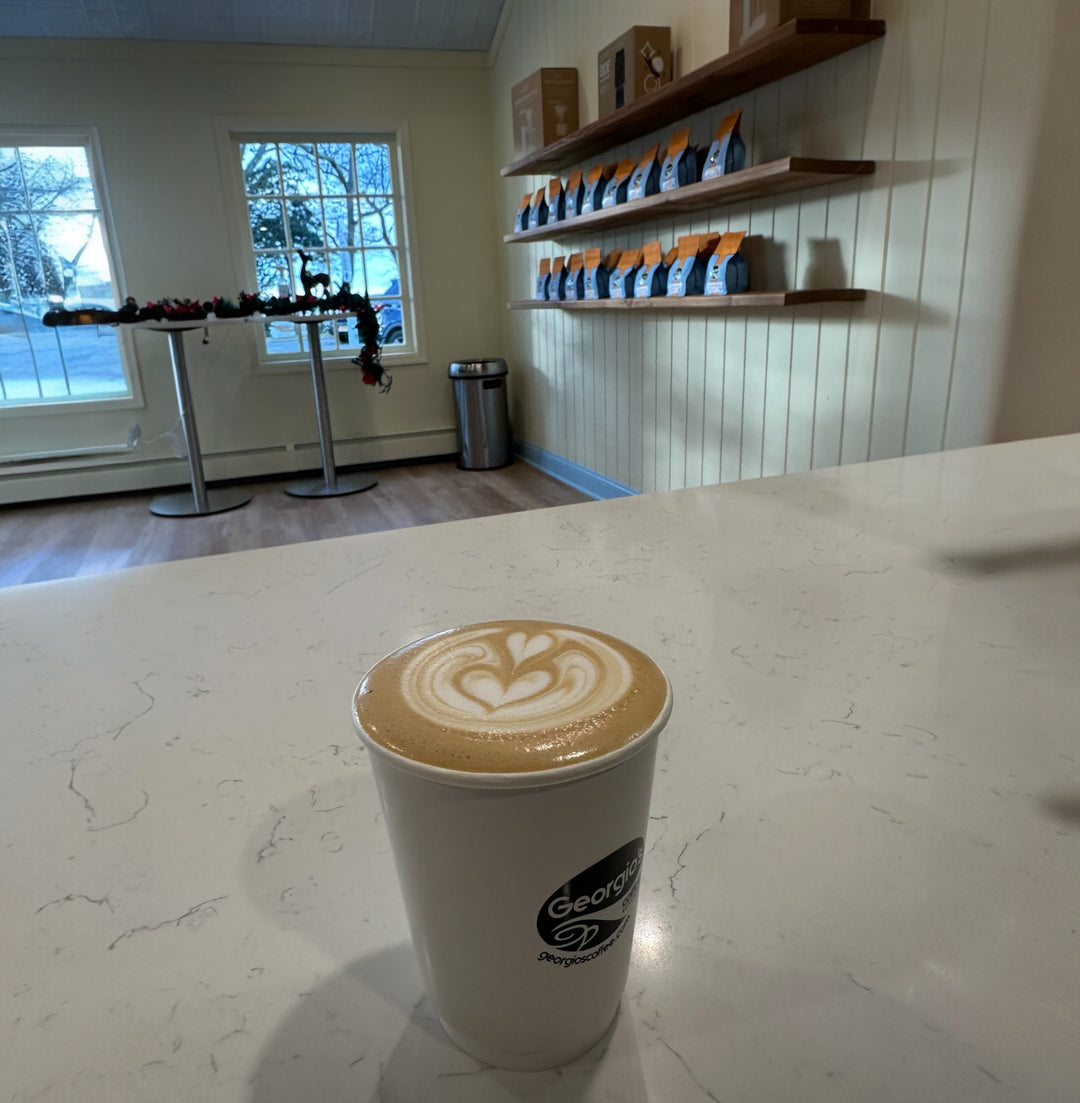The Effects Of Grind Size On Coffee

Are you a coffee lover who wants to take your brewing skills to the next level?
One key factor that can greatly impact the taste and quality of your coffee is the grind size. The size of the coffee grounds can make a world of difference in the flavors and aromas that end up in your cup.
When it comes to coffee extraction, grind size plays a crucial role. The extraction process involves dissolving the soluble compounds in coffee grounds with water, and the size of the grounds determines how quickly and evenly this process occurs.
Finely ground coffee, for example, has a larger surface area, allowing for faster extraction. On the other hand, coarsely ground coffee takes longer to extract, resulting in a different flavor profile.
By understanding the relationship between grind size and brewing methods, you can tailor your brewing technique to achieve the perfect cup of coffee that suits your preferences.
So, grab your grinder and get ready to explore the impact of grind size on the flavors and aromas of your beloved beverage.
The Role of Grind Size in Coffee Extraction
Grind size has a massive impact on the flavor and strength of your coffee, so choosing the perfect grind is essential for extracting the perfect cup of joe.
When it comes to coffee extraction, grind size determines the surface area of the coffee particles that come into contact with water. Finely ground coffee has a larger surface area, allowing for a faster extraction process. This means that the water can extract more flavor compounds from the coffee in a shorter amount of time, resulting in a stronger and more intense cup of coffee.
Alternatively, coarsely ground coffee has a smaller surface area, leading to a slower extraction process. This allows for a more controlled extraction, resulting in a milder and smoother cup of coffee. The larger particles of coarsely ground coffee also allow water to flow more freely through the coffee bed, preventing over-extraction and the extraction of unwanted bitter compounds.
Basically, if you prefer a stronger and bolder cup of coffee, opt for a finer grind size, and if you enjoy a more delicate and balanced flavor, choose a coarser grind size.
Remember, the perfect grind size is subjective and depends on your personal taste preferences. So, experiment with different grind sizes to find the one that suits your palate best.
The Relationship Between Grind Size and Brewing Methods
When you want a rich and bold cup of coffee, the key lies in finding the perfect match between the size of your grounds and the brewing method you choose. The relationship between grind size and brewing methods is crucial because it directly affects the extraction process.
Different brewing methods require different grind sizes to achieve the desired flavor profile. For example, if you're using a French press, you'll need a coarse grind size. This allows for a longer steeping time, resulting in a fuller-bodied and more robust cup of coffee. If you're using a pour-over method, a medium grind size is recommended. This allows for a balanced extraction, bringing out the flavors and aromas of the coffee beans without any bitterness.
By understanding the relationship between grind size and brewing methods, you can tailor your coffee-making process to achieve the perfect cup every time.
The relationship between grind size and brewing methods goes beyond just flavor. It also affects the brewing time and the overall brewing experience. Finer grind sizes tend to extract more quickly, while coarser grind sizes take longer. This means that if you use the wrong grind size for your brewing method, you may end up with over-extracted or under-extracted coffee.
Over-extracted coffee can taste bitter and unpleasant, while under-extracted coffee can taste weak and watery. By adjusting the grind size to match your brewing method, you can control the brewing time and ensure a balanced extraction. This will result in a cup of coffee that's full-bodied, flavorful, and satisfying.
The next time you brew a cup of coffee, remember to consider the relationship between grind size and brewing methods. It's a small but important detail that can make a big difference in the taste and quality of your coffee.
Achieving the Perfect Grind Size for Your Brewing Preferences
To achieve the perfect grind size for your brewing preferences, you'll need to consider factors such as your desired flavor profile, extraction time, and overall brewing experience.
Different brewing methods require different grind sizes to extract the best flavors from the coffee beans. For example, if you prefer a strong and bold cup of coffee, a finer grind size is recommended. This allows for a longer extraction time, resulting in a more intense flavor. On the other hand, if you prefer a milder and smoother cup, coarser grind size is the way to go. This allows for a shorter extraction time, preventing over-extraction and producing a more balanced and delicate flavor.
In addition to flavor preference, extraction time is an important factor to consider when determining the perfect grind size. Extraction time refers to the amount of time it takes for hot water to come into contact with the coffee grounds during brewing. A finer grind size will increase the surface area of the coffee grounds, allowing for a faster extraction. Conversely, a coarser grind size will decrease the surface area, resulting in a slower extraction. By adjusting the grind size, you can control the extraction time and therefore the strength and flavor of your coffee.
Lastly, it's important to consider your overall brewing experience when choosing the perfect grind size. The grind size affects the brewing process and can impact the ease and convenience of preparing your coffee. Finer grind sizes tend to be more challenging to work with, as they can clog up filters and require more precise brewing techniques. On the other hand, coarser grind sizes are generally easier to work with and are more forgiving in terms of brewing mistakes. Therefore, it's important to find a grind size that not only produces your desired flavor but also aligns with your brewing skills and preferences.
Impact of Grind Size on Flavor and Aroma
If you want to truly savor the rich flavors and enticing aroma of your coffee, paying attention to the size of the grounds is crucial. The grind size has a significant impact on both the flavor and aroma of your brew.
When the coffee grounds are too fine, they can over-extract during the brewing process, resulting in a bitter and unpleasant taste. On the other hand, if the grind size is too coarse, the coffee may be under-extracted, leading to a weak and lackluster flavor. Finding the perfect grind size for your brewing preferences is essential to achieving a balanced and flavorful cup of coffee.
The size of the coffee grounds also affects the aroma of your brew. When the grounds are finely ground, they have a larger surface area, allowing for more extraction of the coffee's volatile compounds. This leads to a more intense and aromatic cup of coffee. Conversely, if the grounds are too coarse, the extraction process may not release enough of these compounds, resulting in a weaker aroma.
By adjusting the grind size to your liking, you can enhance the aroma of your coffee and create a more enjoyable sensory experience. So, next time you brew a cup of coffee, take a moment to consider the grind size, and you'll be rewarded with a delightful and aromatic cup of joe.
Experimenting with Different Grind Sizes for Coffee Perfection
Discover the secret to unlocking the full potential of your favorite brew by exploring a range of grind sizes and experiencing the remarkable transformation of flavors and aromas.
Experimenting with different grind sizes allows you to tailor your coffee to your personal taste preferences. Whether you prefer a bold and robust flavor or a delicate and nuanced aroma, adjusting the grind size can make all the difference.
When it comes to grind size, there is no one-size-fits-all approach. By experimenting with finer or coarser grinds, you can discover a whole new world of taste sensations.
A finer grind size generally results in a stronger, more intense flavor, as the increased surface area allows for greater extraction of oils and flavors. A coarser grind size can produce a milder, smoother cup of coffee with a lighter body.
By playing with different grind sizes, you have the power to create a truly personalized coffee experience that is perfectly suited to your palate. So, go ahead and embark on a grind-size adventure to find your coffee perfection.
Grind Size Effects More Than You'd Think!
Understanding the effects of grind size on coffee is essential for achieving the perfect cup of joe. By experimenting with different grind sizes, you can tailor your brewing method to suit your personal preferences.
Whether you prefer a coarse grind for a French press or a fine grind for an espresso machine, the size of your coffee grounds plays a crucial role in the extraction process.
Not only does grind size affect the brewing time and method, but it also has a significant impact on the flavor and aroma of your coffee. Finer grinds tend to result in a stronger, more intense flavor, while coarser grinds produce a milder, smoother taste. The aroma of your coffee is also influenced by the grind size, with finer grinds releasing more fragrant and aromatic notes.
The grind size of your coffee grounds is a key factor in determining the overall quality and taste of your coffee. By understanding the relationship between grind size and brewing methods, and by experimenting with different grind sizes, you can find the perfect balance to suit your personal preferences.
Freshly ground coffee vastly improves the flavor and experience of coffee drinking. So go ahead, start grinding your coffee to perfection, and enjoy a truly satisfying and flavorful cup every time.







